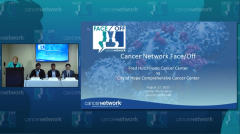
Cross Q&A: Balancing Progression and Lines of Therapy at Myeloma Relapse
Expert insights into tailoring treatment for biochemical relapse in multiple myeloma patients, considering disease progression and the impact of various therapy lines on treatment decisions.
Episodes in this series

Transcript:
Rahul Banerjee, MD, FACP: A question for Dr Cowan and Dr Liu and Dr Janakiram would be, do you modulate the answer to this question about chemical vs clinical relapse treatment based on line of therapy? I would argue for someone on [a] third or fourth line of therapy, I probably do treat a biochemical progression maybe slightly more seriously, just because of the risk of oligosecretory relapse or something bad happen[ing] because the pathology of the disease physiology is different, vs in first line, I agree. I might try to keep the REVLIMID [lenalidomide] on for a little bit longer…if they don’t want to change treatment in second-line therapy right away. Curious to hear if you guys change your approach based on where [patients] are in their disease journey.
Andrew J. Cowan, MD: Yes, Dr Banerjee, that’s a great question. I think it really depends. As I showed earlier in my slide, multiple myeloma is a very heterogeneous disease. We know this from patients arriving to CAR [chimeric antigen receptor] T cells. We have patients [who have] MGUS [monoclonal gammopathy of undetermined significance]-like myeloma relapse, and they might have had 6 lines of therapy. Then we have patients [who] are [at] 3 lines of therapy or 2 lines [and] are just…falling apart. I don’t think lines of therapy is necessarily a good barometer for how to manage disease. This is where longitudinal care of the patient really is important. It’s familiarity with the pattern of relapse and what the patient has done. I think this is the skill we all learn when we treat myeloma, identifying these patients and getting back to the old maxim of sick or not sick. We have to use that with myeloma.
There are certainly patients who’ve had 6 lines of therapies who I feel very comfortable just watching an M-spike of 0.5. I’m not going to go in and just beat them up with a 4-drug regimen or start a bispecific right away. But…to your point about oligosecretory disease, EMD [extramedullary disease], those are all more likely to occur as a patient’s had myeloma for longer. Going back to the chart I showed, we do see more clonal evolution as patients have been living with the disease for longer.… Over time, you have to be vigilant for those manifestations—EMD, secondary plasma cell leukemia—because they can occur suddenly in a patient who you feel…has been doing really well for quite a while. I think it is a complicated issue, but I don’t think you can just take a one-size-fits-all [approach and] say [at] 3 lines, I’m going to just treat, whereas [at] 2 lines, I won’t. But I’m interested in my colleagues at City of Hope and what they do.
Murali Janakiram, MD, MS: I think it’s a great question. I think there are 2 answers to this question. One is what Dr Cowan said. If you look at the individual patient and if I know their longitudinal history, then I can adapt my treatment according to the biochemical relapse. But if you ask me at a population level what I would do, I would say that at the first line of therapy, the lead time bias will be much higher. We can wait for the biochemical relapse, where PFS [progression-free survival] and OS [overall survival] will not translate in parallel.
But as we go through lines of therapy, I think this lead time bias will cut down very short, and PFS and OS will start correlating stronger. If you…ask me at a population level at 3, 4, or 5 lines, then I think it’s better to do that biochemical relapse, even though I don’t have any great data supporting it. But there are studies, which Dr Cowan just showed, [showing] that at second line, it is improving overall survival. That’s my answer to this question. At the population level, yes. Deeper [in] the lines, I will treat it biochemical relapse. At an individual level, I will more individualize according to the patient.
Lawrence W. Liu, MD: I think also with a lot of the current studies, when they report on extramedullary disease and heavy disease burden…it gets scary to wait a little bit. You…wonder when the patient gets to having high disease burden, are they going to not respond to later T-cell redirection therapies? I think that’s also…a nuanced thought in this realm. It’s just a tough area and tightrope to walk.
Judy Schreiber, PhD, RN: Thank you. These have been great comments.
Transcript is AI-generated and edited for clarity and readability.
Newsletter
Stay up to date on recent advances in the multidisciplinary approach to cancer.



















































































